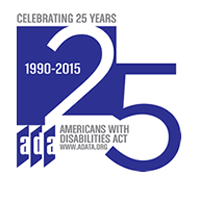Has the ADA measured up? Legislation drafter weighs in 25 years later

Image courtesy of the ADA National Network.
Robert Burgdorf was the right person in the right place at the right time at the birth of the Americans with Disabilities Act.
He contracted polio as an infant and lost much of the use of one arm and shoulder, regaining some through innovative surgery at age 11. During law school at the University of Notre Dame in 1972, he helped establish a now-defunct national center for disability rights advocacy. In 1984 he co-authored a “Statutory Blueprint,” published by what became the ABA Commission on Disability Rights, which was a broad road map for the ADA. (He would go on the commission from 2002-2006.) As a staffer for the National Council on Disability, he authored draft legislation in 1988 that led to the Supreme Court citing him as “the drafter of the original ADA bill.” The Americans with Disabilities Act was passed on July 26, 1990. Burgdorf is professor emeritus at the David A. Clarke School of law in Washington, D.C., and he is writing a history of the disability rights movement and the ADA. He also wrote “A Dozen Things to Know about the ADA on its 25th Anniversary.”
Q: Before the ADA, there were terrible stories about discrimination against those with disabilities. How were people treated then?
A: Things were quite bad before the disability rights movement started in the early 1970s. Accessibility of public transportation and public buildings was almost unheard of. More than half of all kids with disabilities were not receiving an appropriate education, and about a million were totally excluded from public schools. Many people were institutionalized in horrendous conditions. There were involuntary sterilizations, withholding of lifesaving medical care, and so-called ugly laws saying people with “unsightly or disfiguring” disabilities could not be seen in public. This all continued into the 1970s, when disability rights lawsuits and consumer activism began to make a difference and led to federal laws in the mid-’70s that in some ways foreshadowed the ADA.
Q: ADA legislation came on the heels of landmark civil rights and anti-discrimination legislation. How did that relate to the ADA movement?
A: It resulted from a chain of events and circumstances. The civil rights movement and especially the 1964 Civil Rights Act were models. Successes in the courts in the early 1970s helped, particularly in cases dealing with access to public education and battles against horrible conditions in state residential institutions. As to the latter, a federal court in Alabama (Wyatt v. Stickney in 1971) said people involuntarily institutionalized for mental illness or intellectual disabilities must be treated humanely and get treatment or habilitation that might help them return to life on the outside.
Q: You’d already begun working on disability rights issues, but how is it that you were tapped to draft what would become the ADA?
A: Congress established National Council on Disability as an independent federal agency in 1984, and I came the following year as research specialist and the only attorney. A nationwide Harris poll had shown that people with disabilities were disadvantaged, experienced discrimination, and were often isolated at home. It wasn’t right, it was costly, and the council (Reagan appointees) wanted to do something. I was asked to write a report that recommended a comprehensive nondiscrimination law, and then was asked to draft one. And in a bold and brilliant move, NCD published it. Grassroots organizers saw it and talked to members of Congress in favor of it. It generated a lot of outside support.
Q: The ADA has been the subject of litigation from the start. How well did the courts do interpreting the legislation?
A: Other than on the issue of what is a disability, there have been a lot of favorable decisions. Though Congress made it clear this was a comprehensive law to prohibit discrimination, some lower courts took a strict view of disability, and created demanding standards for qualifying as a person with a disability. The Supreme Court got on that bandwagon in 1999 with the Sutton case and then the Toyota case in 2002, in which the court expressly declared that it was adopting a restrictive interpretation and demanding standard of disability. More than 95 percent of employment cases were thrown out, mostly on that issue.
Q: That sounds like a significant weakening of the ADA, yet there are more favorable rulings now. How did it turn around?
A: Bad rulings were coming out, and advocates and commentators complained loudly. NCD commissioned me to do a report titled “Righting the ADA” (PDF) cataloguing the destructive court decisions and providing a draft bill for addressing them. It provided a basis for bills in Congress, though significantly altered, to overturn those decisions with the ADA Amendments Act of 2008. Subsequent cases are coming through the courts now, and most of them have been favorable so far.
Q: With legislation, there are always sacrifices and compromises, but did the ADA as it is now accomplish its objectives?
A: In a variety of ways, it has lived up to high hopes. It’s hard to deny the ADA’s strong impact in ameliorating discrimination and integrating those with disabilities into society. It brought about a dramatic expansion in the accessibility of government and commercial buildings, transportation systems, and public accommodations, including shops, parks, and recreation facilities. It has enhanced telecommunication services for those with disabilities, prohibited discrimination against people with HIV, and improved hiring practices by eliminating things like disability inquiries. But in each area of accomplishment, there are far too many situations in which the ADA is not being followed—big gaps in enforcement. And remember, the ADA is not a panacea. It’s a civil rights law to prevent discrimination. It doesn’t create resources and programs those with disabilities might need. But it has been transforming the social fabric of our nation.
Q: Given today’s political climate, do you think the ADA would pass?
A: Maybe. If anything could pass—which is usually a question these days—this might be it. The ADA was overwhelmingly bipartisan. But now Congress can’t even join other nations in the U.N.’s Convention on the Rights of Persons with Disabilities, which was based on our ADA.
See also:
ABA Journal: “The biggest hurdle for lawyers with disabilities: preconceptions”



